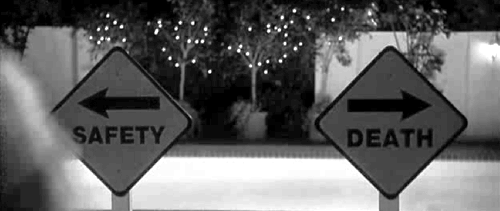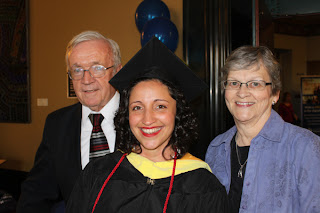| Piled Higher & Deeper by Jorge Cham |
www.phdcomics.com
|
|
 |
||
|
title:
"Frozen" - originally published
5/7/2014
For the latest news in PHD Comics, CLICK HERE! |
||
Allenroda
Shared posts
05/07/14 PHD comic: 'Frozen'
Three-Dimensional Mid-Air Acoustic Manipulation [Acoustic Levitation]
Allenrodaawesome.
The essence of levitation technology is the countervailing of gravity. It is known that an ultrasound standing wave is capable of suspending small particles at its sound pressure nodes and, so far, this method has been used to levitate lightweight particles, small creatures, and water droplets.
The acoustic axis of the ultrasound beam in these previous studies was parallel to the gravitational force, and the levitated objects were manipulated along the fixed axis (i.e. one-dimensionally) by controlling the phases or frequencies of bolted Langevin-type transducers. In the present study, we considered extended acoustic manipulation whereby millimetre-sized particles were levitated and moved three-dimensionally by localised ultrasonic standing waves, which were generated by ultrasonic phased arrays. Our manipulation system has two original features. One is the direction of the ultrasound beam, which is arbitrary because the force acting toward its centre is also utilised. The other is the manipulation principle by which a localised standing wave is generated at an arbitrary position and moved three-dimensionally by opposed and ultrasonic phased arrays. We experimentally confirmed that various materials could be manipulated by our proposed method.
The Surprising Reason We Don’t Tip Flight Attendants
When the airline industry first tried to go commercial after World War I, it needed to convince skeptical customers that air travel was safe. One strategy was to make passengers feel that the entire crew was able and willing to see to their safety. This included the stewards, the all-male precursors to the stewardess. But which men to hire? The default employee should have been an African American. Ocean liners and train cars, air travel’s main competitors and the model on which they built their business, largely employed Black porters and stewards. But the airlines believed that the overwhelmingly White passengers would not have felt comfortable placing their lives in the hands of Black men. So they hired White men instead. Kathleen Barry, who discusses this in her book Femininity in Flight, explains:
Equanimity on aircraft circa 1930 was a tall order for anyone, but stereotypes dictated that it would most likely come from white male attendants. With uniforms that echoed the naval-style garb of pilots, stewards reassured passengers that the white men in the cabin as well as the cockpit were competent and in control.
If stewards were so capable and appreciated, why not offer one’s appreciation in cash? The answer is, in short, because tips were for Black people. Black porters on trains and boats were tipped as a matter of course but, according to Barry, tipping a White person would have been equivalent to an insult. A journalist, writing in 1902, captured the thinking of the time when he expressed shock and dismay that “any native-born American could consent” to accepting a tip. ”Tips go with servility,” he said. Accepting one was equivalent to affirming “I am less than you.” This interpretation of the meaning of a gratuity, alongside airlines’ need to inspire confidence and simple racism, is why we don’t tip flight attendants today.
Lisa Wade is a professor of sociology at Occidental College. You can follow her on Twitter and Facebook.(View original at http://thesocietypages.org/socimages)
Kyrgyzstan 1 - USA 0...New Dimensions discovered!
AllenrodaI want 5D movies.
Presumably, you pay about 30 soums (60 cents) to pretend to be a Mom that cooks? Interesting.
In this same place, called Detsky Mir, we also discovered the 5th dimension. Well, we found where they were keeping it, harnessing it, or whatever. Now, my Russian is not good, so I can't completely describe what the 5th dimension is, but it looks like this...
Imagine my surprise, later in the day, when we took our son to the local amusement park at Panfilova Park, to discover that they had uncovered EVEN MORE DIMENSIONS!!!
In order of escalating Physics Absurdity...
Thankfully, the madness stopped at 10 dimensions. For now at least.
And yes, I realize that there may be
1. An issue of translation
2. More dimensions lurking
3. Some other thing, like amount of speakers, range of movement of the seats etc. that these numbers are describing...BUT
I prefer to see it my way, which is, to embrace my reality, my krazystan.
Kyrgyzstan 1 - USA 0
Allenrodamy friend Jameel just moved to kyrgistan and this is his blog...
Today we walked a new way around town and approached this statue
Which of course I assumed was some sort of surrealist chicken, a giant Joan Miro or something. Unfortunately, when we got to the other side, it turned into this...
Which is actually pretty cool as Kozhomkul is a real/mythical 20th century Kyrgyz wrestler (btw, the best thing I did before coming here was learn to read Cyrillic).
To me, this is like if NYC decided to erect a giant statue of Andre the Giant overturning a car of French jerks. So Bishkek, you win this round...
Robot Gymnast Sticks The Landing On Qaudruple Backflip
 Seen here performing in somebody's decrepit basement circus, a little robot executes a quadruple backflip dismount from a horizontal bar. If you couldn't tell, this is a composite image I made using a couple in-flip action shots. Will robots start taking home gold in the Olympics? When reached for comment, 2008 gymnastics all-around silver medalist Shawn Johnson had this to say, "What news show did you say you were with again?" Channel Six with April O'Neil -- this is Barry Hansome reporting. Hello? HELLO? *slams banana on counter*
Hit the jump for the video.
Thanks to SharkDiddler, who's braver than I am.
Seen here performing in somebody's decrepit basement circus, a little robot executes a quadruple backflip dismount from a horizontal bar. If you couldn't tell, this is a composite image I made using a couple in-flip action shots. Will robots start taking home gold in the Olympics? When reached for comment, 2008 gymnastics all-around silver medalist Shawn Johnson had this to say, "What news show did you say you were with again?" Channel Six with April O'Neil -- this is Barry Hansome reporting. Hello? HELLO? *slams banana on counter*
Hit the jump for the video.
Thanks to SharkDiddler, who's braver than I am.
Back to New York City, Again!
Nikki's Graduation! - by Guest Blogger Allen!
Allenroda#selfshare
Then they started presenting student awards. Nikki had said something that morning about there being awards given out for academic achievement and professional promise, as well as one that was chosen by the students to honor a fellow student dedicated to "service, empathy, confidence-building, industry and responsibility." When they began to announce these awards, I was just sure that Nikki was going to get one, because she was such an awesome student – how could she not? Alas, the awards went to other students – who most certainly deserved them – but since I am Nikki’s husband I am allowed to be biased.
If you can't read all the captions in the video, I typed them out for you:
The honor wasn’t for Nikki’s any particular achievement – although they cited all the work she did for the DataDive, the Student Clubs and Organizations, Alternate Spring Break, and Service Day as examples of ways in which she gave back to the School and the community – no the award wasn’t for any of those accomplishments, it was for being who Nikki is. A person who doesn’t just talk about doing things, but gets them done – whose heart is so full, so generous, and caring that she can’t help herself but to help others when she has the ability and the opportunity.
As she explained in planning the first A2 DataDive – “We have the Skills, We’d be doing something really good for the world, and It would be really cool.”
This “Space Oddity” Cover From the Space Station Is Amazing
Canadian astronaut Chris Hadfield has spent the past five months as the commander of Expedition 35 aboard the International Space Station. While in space, he's made sandwiches, washed his hands, and wrung water from a wet towel. But on Sunday afternoon, Hadfield provided the internet with his most amazing video yet: a cover of David Bowie's 1969 classic, “Space Oddity.”
Apparently, St. Ignatius of Loyola was a regular Miss Emily...

Apparently, St. Ignatius of Loyola was a regular Miss Emily Davison.
Oh, just go google it.
Infographic: Is Your State's Highest-Paid Employee A Coach? (Probably)
90-Year Old Grandma Going Wild For Virtual Reality
 This is a video of a 90-year old grandma wearing Oculus Rift virtual reality goggles and taking a tour of Tuscany. And let me tell you -- she is LOVING IT. When I'm old I want VR goggles fused to my eyeballs so I can live out the remainder of my life in virtual paradise instead of the D-grade nursing home my ungrateful children are sure to stick me in. They're not even born yet and I can already tell they're gonna be letdowns. The apple doesn't fall far from the tree and all that.
Hit the jump for the feel-good video.
This is a video of a 90-year old grandma wearing Oculus Rift virtual reality goggles and taking a tour of Tuscany. And let me tell you -- she is LOVING IT. When I'm old I want VR goggles fused to my eyeballs so I can live out the remainder of my life in virtual paradise instead of the D-grade nursing home my ungrateful children are sure to stick me in. They're not even born yet and I can already tell they're gonna be letdowns. The apple doesn't fall far from the tree and all that.
Hit the jump for the feel-good video.The Late Movies: Bluegrass Covers
I love bluegrass, and I love quirky, unexpected cover songs. Smash the two together and I’m in heaven. Bluegrass pioneer Bill Monroe described the genre as “Scottish bagpipes and ole-time fiddlin'. It's Methodist and Holiness and Baptist. It's blues and jazz, and it has a high lonesome sound." Those aren’t words I would use to describe a lot of modern pop and rock music, but the incongruity of fiddles and distorted guitar, fat beats and down-home twang makes these bluegrass covers very endearing.
“Single Ladies”
The Cleverlys are a comedy-bluegrass group that, according to the band, is made up of members of a famed tobacco growing family from rural Cane Spur, Arkansas. They’re generally awesome, and their take on Beyonce is especially so.
“Creeping Death”
Iron Horse is a bluegrass band from Muscle Shoals, Alabama, that has recorded bluegrass tributes to Guns N’ Roses, Ozzy Osbourne, Metallica, Van Halen and, um, the Goo Goo Dolls. I especially like their take on this Metallica song, the Biblical themes of which make it a natural fit for bluegrass.
“The Way You Make Me Feel”
When you think of the “King of Pop,” you don’t think of three goofy looking (naturally) white dudes cruising around small town America in the back of a pickup truck with a standup bass, but Honeywagon makes it work.
“Blinded by Fear”
Swedish death metal filtered through bluegrass sounds less like bluegrass and a little more like something gypsy punks Gogol Bordello might come up with. Still awesome.
“I’m on Fire”
This just wouldn’t be a Matt Soniak music post without some mention of The Boss, would it? Even more so than tackling death metal with banjos, this cover really changes the whole sound of the original song. Bruce’s version is cold, desolate, minimal and tight. In the hands of Town Mountain, though, the song is full, warm, inviting and even has a little bit of swing.
“Bohemian Rhapsody” and “Centerfold”
Hayseed Dixie goes the extra mile on both these songs, not only having fun with the Queen classic and The J. Geils Band hit, but also making great videos for them. They ape the “floating faces” shots from Queen’s video and kick up the speed on Geils and company’s original video to sync with their faster version of the tune.
“I Gotta Feeling”
Given that it’s been played at every wedding reception I have been to in the last few years (and probably every one I haven’t been too, also), I get that this song is supposed to be a feel good, barn burning party anthem. But I didn’t get it. The Black Eyed Peas version doesn’t make me feel good, it doesn’t make me want to dance, and doesn’t make me think tonight’s gonna be a good night. It has all the charisma of a dead fish. Then, the Cleverlys took a stab at it and I got it! It’s fun, it’s funny and it makes me want to fill a mason jar with Cristal and hit the town with a banjo on my knee.
“Dancing in the Dark”
And one more Bruce song. This track from Born in the USA is a favorite around here, and the boys in Greensky Bluegrass do an admirable job with it. Bonus points for the great beard on the mandolin player.
    
|
Guest Photoshopperist Vanessa strikes again.

Guest Photoshopperist Vanessa strikes again.
Is Community A Postmodern Masterpiece? | Idea Channel | PBS Digital Studios
Allenrodaso I watched one episode of community once, and I was like, "meh" - I kind of feel the same way about Arrested Development, Family Guy, and Parks and Recreation. The schizophrenic pacing from one scene to the next just doesn't work for me. I love the IT crowd, though and am looking for a new comedy to follow on Netflix. Suggestions?
|
Here's an idea: Community is a postmodern masterpiece. Though the TV show Community has never achieved huge ratings, it has a passionate cult following, incl...
|
From:
pbsideachannel
Views:
193717
    
5474
ratings
|
|
| Time: 08:28 | More in Education |
http://feedproxy.google.com/~r/AsaBurtonsGhost/~3/lnnwSXIbR0M/via-instagram-httpinstagram_3740.html
CHOOSING TO GO INTO ACADEMIA

Building a Theremincello

We totally missed the ball on this project. It should have been run on April Fools’ day and you would have no idea if it were real or a hoax. That’s because the very serious performance given after the break is hard to watch without a least a bit of a chuckle. The instrument shown above is a Theremincello. It’s an instrument in the shape of a cello which functions in a similar way to a Theremin.
The instrument being played in that video clip is the first generation and the one pictured above is its successor. The creator wanted to refine the electronics so that the resulting sound wasn’t so ‘flutey’. The result can be heard on the video embedded in this Theremin World article and we think they’ve accomplished the goal; it sounds much better! In the clip [Thierry Frenkel] demonstrates changing notes on the fingerboard with the left hand. The right hand which would normally bow the strings operates the lever to adjust the volume of the note being played back.
If a single fingerboard isn’t enough for your needs you may consider building this four-track design instead.
[Thanks David]
Filed under: musical hacks
Eventually, of course, the Cathars were wiped out by the evil...

Eventually, of course, the Cathars were wiped out by the evil Knights in White Satin.
Food Faddism
If there’s one thing Americans love, it’s food faddism. The history of full of weirdness, from John Harvey Kellogg’s yogurt enemas that placed yogurt cultures in our mouths and rectums at the exact same time to Sylvester Graham’s graham crackers, created so we wouldn’t eat meat and milk and get all hot and bothered and start masturbating.
We (or at least my students) laugh at all this. But are we any different today with our nutty diets? Not really.
Luckily, there are at least some people pushing back against this. Here’s a discussion of the new Marlene Zuk book exposing the absurdity of the paleo diet. The paleo diet falls under the overarching theme of recent American dieting, which can be summarized as “I want to eat as much meat as possible and will look for any justification to do so.” And do whatever you want, but it’d be nice to avoid the absurd discussions about what our distant ancestors did or did not eat.
Zuk detects an unspoken, barely formed assumption that humanity essentially stopped evolving in the Stone Age and that our bodies are “stuck” in a state that was perfectly adapted to survive in the paleolithic environment. Sometimes you hear that the intervention of “culture” has halted the process of natural selection. This, “Paleofantasy” points out, flies in the face of facts. Living things are always and continuously in the process of adapting to the changing conditions of their environment, and the emergence of lactase persistence indicates that culture (in this case, the practice of keeping livestock for meat and hides) simply becomes another one of those conditions.
For this reason, generalizations about the typical hunter-gatherer lifestyle are spurious; it doesn’t exist. With respect to what people ate (especially how much meat), the only safe assumption was “whatever they could get,” something that to this day varies greatly depending on where they live. Recently, researchers discovered evidence that people in Europe were grinding and cooking grain (a paleo-diet bugaboo) as far back as 30,000 years ago, even if they weren’t actually cultivating it. “A strong body of evidence,” Zuk writes, “points to many changes in our genome since humans spread across the planet and developed agriculture, making it difficult at best to point to a single way of eating to which we were, and remain, best suited.”
But what is evidence in the face of food faddism?
And of course there’s the gluten-free insanity. While celiac disease is a real thing that affects about 1% of the population, the fact that 1/3 of the American public is trying to shun gluten is insane. There is zero evidence that most of these people need to do this. Anecdotally, it definitely feels that a good number of people I have met who are avoiding gluten are, how shall we say, lifestyle experimenters more broadly. More broadly, I think this relates to the paleo diet in the context of how dieting has gone over the past 15 years–again, avoiding grains and eating meat. What makes gluten-free different is the theoretical health benefits as opposed to the I want to eat a steak every night blunt honesty of the paleo dieters.
Obviously, the answer to proper eating is to be healthy and exercise. One can choose whether or not to eat meat for any number of reasons. I was a vegetarian for about 10 years but couldn’t call myself that now, although I have never cooked meat and don’t really plan to. We can have that debate. But it’s remarkable how resilient magic diets are for Americans (and possibly those of other countries, but I can’t much speak to that). They all pretty much defy common sense.
All I can do is eat more wheat and drink more beer. Both of which I intend to do.
PC: I recommend Barry Glassner’s The Gospel of Food on this topic.
[SL]: Related: “I personally feel that it’s unlikely that the richest 1% of humans on earth all suddenly and simultaneously developed allergies to every single common food…”
What became of Detroit?
As Detroit approaches a new turn in its difficult journey over the past several decades, the imposition of an Emergency Financial Manager by the governor of Michigan (link), many people are asking a difficult question: how did we get to this point?
The features that need explanation all fall within a general theme -- the decline of a once-great American city. The city's population is now roughly 40% of its peak of almost two million residents in 1950 (link); the tax revenues for city government fall far short of what is needed to support a decent level of crucial city services; the school system is failing perhaps half of the children it serves; and poverty seems a permanent condition for a large percentage of the city. The decline is economic; it is political; it is demographic; it is fiscal; and it is of course a decline in the quality of life for the majority of the residents of the city. The poverty, unemployment, poor housing, poor health, and high crime that characterize the city must surely have an explanation.
There are several standard lines of interpretation that Michiganders offer each other -- the decline of manufacturing and the auto industry; the workings of race and white flight; the uprising of 1967; ineffective and corrupt city management; and a long and debilitating contagion of rustbelt-itis in common with Cleveland, Peoria, and Gary. Each of these has a role to play in the explanation, but it is complicated to see how these factors may have intertwined in the half-century of change that led to the Detroit of 2013.
The decline of manufacturing employment in Detroit and its inner suburbs is certainly a contributing factor to the economic decline of the city of Detroit, but these changes by themselves do not account for the major contours of Detroit's economic decline. In a careful review article on manufacturing employment in Michigan (link), Richard Block and Dale Belman show that the decline of vehicle manufacturing employment for the state of Michigan as a whole was measurable but slow between 1980 and 2001 (152). The loss of jobs has been much more significant since the beginnings of the 2007 recession; but Detroit's decline was well underway by 2007.
What about race and white flight? Certainly Detroit is a much more racially segregated city than it was in 1960, and this increase reflects the relocation of a substantial part of the white population to the affluent suburbs. So white flight is a fact. This racial demographic shift is often attributed to the aftermath of the 1967 uprising. But Tom Sugrue documents very convincingly that this process was already well underway by 1967. White flight predates the occurrence of the uprising by at least a decade (The Origins of the Urban Crisis: Race and Inequality in Postwar Detroit). This transformation of racial demography seems to reflect the vicious circle of urban change that characterizes several of the processes mentioned here. People care about the urban environment in which they live, and if they are unsatisfied and financially able, they will relocate to neighborhoods that provide better quality of life for them. But often their relocation leads to a slight worsening of the environment for others in the neighborhood, leading to a growing flow outward of the more affluent residents. Unfortunately in Detroit's history (like that of many other Midwestern cities) some of those preferences have to do with the racial composition of a neighborhood, resulting in out-migration that is disproportionately white and affluent. But this process has important consequences. Sustained shifting of patterns of residence that result in increasingly impoverished neighborhoods in the central city lead to decline quality of life and declining tax revenues for the city, and another round of relocation.
Another vicious circle in Detroit concerns schooling. The funding of the Detroit Public School system depends on the enrolled student count. Each year for at least the past ten years this count has been lower than the prior year. This means a continuing fiscal crisis for the schools, and a continuing downward spiral of funding and school population. Parents perceive lower quality as a result of reduced funding; they find alternative schools for their children; and the count declines further. But crucially, the quality of schools is a key determinant of the quality of life of a city and its attractiveness as a destination for young families. So declining school quality reinforces population loss.
Another important factor is the quality of housing and neighborhoods in the city. The city has a legacy of blight and decay that is very costly to deal with. The precipitous decline of population has left large parts of the city very sparsely populated, with a high number of abandoned buildings and vacant lots. This low density residential pattern makes it costly to deliver basic urban services like police, fire, sanitation, and infrastructure maintenance. So in addition to a declining tax base, the city has to deal with the challenge that its urban geography implies that services will cost more per capita than they do in more densely populated cities.
So what about the creation of new jobs as a way of combatting these downward spirals? Employers need a well educated workforce. Detroit's ability to educate its children and young adults is impaired; rates of basic literacy are low; and therefore it is difficult to persuade employers to establish new activities in the city. So it is predicable that job growth in the city will be slow.
Finally, what about waste, mismanagement, and fraud in city government? Is this a primary cause of Detroit's decline? Certainly there are examples of each of these problems in Detroit's history. The current trial of former mayor Kwame Kilpatrick lifts the veil from some of these practices. But the current mayor's administration has a good reputation, and it hasn't been possible for the city to make progress on its fiscal crisis during his administration either. Bringing the volume of waste, mismanagement, and fraud down to "normal" levels won't solve the city's fiscal crisis.
If I had to single out a single fact out of this complicated story as the most important factor that led to these toxic changes, I would identify the mechanisms of racial residential segregation that Detroit has embodied for almost a century. For decades Eight Mile represented a key racial division in the city, and a plethora of mechanisms of exclusion conspired to maintain this division. If the city could have settled into a racially and economically mixed pattern of residence in the 1940s, much of this story would have been different. Population exit would not have reached crisis proportions; businesses would have been less likely to relocate out of the city; and a schooling system that was very successful in the 1950s could have maintained its effectiveness. This implies that Detroit is victim to the continuing tragedy of America's inability to heal its racial divisions and antagonisms. Doug Massey and Nancy Denton got it right in their important book, American Apartheid: Segregation and the Making of the Underclass:
Segregation increases the susceptibility of neighborhoods to these spirals of decline. During periods of economic dislocation, a rising concentration of black poverty is associated with the simultaneous concentration of other negative social and economic conditions. Given the high levels of racial segregation characteristic of American urban areas, increases in black poverty such as those observed during the 1970s can only lead to a concentration of housing abandonment, crime, and social disorder, pushing poor black neighborhoods beyond the threshold of stability. (13)So how can Detroit imagine reversing this downward spiral? It's easy to say, though not easy to implement. If Detroit could improve its ability to provide decent, effective education for its children through graduation from high school, and if it could create a process through which tens of thousands of new jobs were created for young people every year, then much of the rest of the picture would change as well. Detroit's young people need education and opportunity; with these assets, they can make their city sing again.
Borromean Critical Theory
 In the next year, I have a lot coming out on what I’m calling “borromean critical theory” (BCT). I introduce the concept in Onto-Cartography, discuss it a bit in “Speculative Realism and Politics”, coming out in Speculations, and discuss it in the next issue of theory@buffalo in an article entitled “The Body of the Sign” (it’s for their Flesh of the World issue). The basic idea is more organizational than anything else (though hopefully it will become something more over time). My thesis is first that what we call “critical theory” (broadly construed), has been largely correlationist in character and has dominantly taken one of two forms. On the one hand, there’s been what might be called “phenomenological critical theory” (PCT) represented by figures like Sara Ahmed and Sandra Bartky, among many others. Here the aim is to investigate the lived experience and embodiment of subaltern bodies. On the other hand, there’s been what might be called “semiotic critical theory” (SCT), where the focus is on the semiotic and semiological structuration of the world. This orientation would be exemplified by historical materialists such as Horkheimer and Adorno, Zizek, Derrida, Barthes, Baudrillard, and so on. I’m sure people will object to characterizing historical materialists or the heirs of pre-Habermasian critical theory and the Althusserian school as “semiotic”, but please note that the basic operation of these orientations of thought consists in showing how the reigning ideology of the time structures knowledge formations and politics (e.g., the claim that x reflects object-oriented program, which in its turn reflects capitalistic, neoliberal ideology). Despite its claim that it focuses on practice, this critical procedure is thoroughly discursive and idealist in character. Finally you get the outliers: Marx himself (not so much his heirs), Latour, the new materialist feminists such as Braidotti, Alaimo, Bennett, Barad, Bianco, the speculative realists, the object-oriented ontologists, media theorists such as Kittler, Ong, McLuhan, Parikka, DeLanda, Deleuze and Guattari, and so on that focus on materiality as materiality or the difference that physical beings make in social assemblages. These figures are giants in fields such as science and technology studies and media studies, but get short shrift in literary theory and philosophy. As an aside, just because you call yourself a materialist it doesn’t follow that you are a materialist. The only legitimate materialism descends from the atomistic tradition of Democritus. If you aren’t talking about physical stuff and the difference that physical stuff makes, you just aren’t a materialist. That’s okay. Just be honest. Sorry Zizek, you’re not a materialist!
In the next year, I have a lot coming out on what I’m calling “borromean critical theory” (BCT). I introduce the concept in Onto-Cartography, discuss it a bit in “Speculative Realism and Politics”, coming out in Speculations, and discuss it in the next issue of theory@buffalo in an article entitled “The Body of the Sign” (it’s for their Flesh of the World issue). The basic idea is more organizational than anything else (though hopefully it will become something more over time). My thesis is first that what we call “critical theory” (broadly construed), has been largely correlationist in character and has dominantly taken one of two forms. On the one hand, there’s been what might be called “phenomenological critical theory” (PCT) represented by figures like Sara Ahmed and Sandra Bartky, among many others. Here the aim is to investigate the lived experience and embodiment of subaltern bodies. On the other hand, there’s been what might be called “semiotic critical theory” (SCT), where the focus is on the semiotic and semiological structuration of the world. This orientation would be exemplified by historical materialists such as Horkheimer and Adorno, Zizek, Derrida, Barthes, Baudrillard, and so on. I’m sure people will object to characterizing historical materialists or the heirs of pre-Habermasian critical theory and the Althusserian school as “semiotic”, but please note that the basic operation of these orientations of thought consists in showing how the reigning ideology of the time structures knowledge formations and politics (e.g., the claim that x reflects object-oriented program, which in its turn reflects capitalistic, neoliberal ideology). Despite its claim that it focuses on practice, this critical procedure is thoroughly discursive and idealist in character. Finally you get the outliers: Marx himself (not so much his heirs), Latour, the new materialist feminists such as Braidotti, Alaimo, Bennett, Barad, Bianco, the speculative realists, the object-oriented ontologists, media theorists such as Kittler, Ong, McLuhan, Parikka, DeLanda, Deleuze and Guattari, and so on that focus on materiality as materiality or the difference that physical beings make in social assemblages. These figures are giants in fields such as science and technology studies and media studies, but get short shrift in literary theory and philosophy. As an aside, just because you call yourself a materialist it doesn’t follow that you are a materialist. The only legitimate materialism descends from the atomistic tradition of Democritus. If you aren’t talking about physical stuff and the difference that physical stuff makes, you just aren’t a materialist. That’s okay. Just be honest. Sorry Zizek, you’re not a materialist!
 Borromean critical theory (BCT) recognizes there’s something right in each of these orientations, but that the claims of each are exaggerated and inflated. It is thus both synthetic (it wants all these orientations) and deflationary (it wants to deflate the imperialistic claims each makes). If you want to have your Uexkull (PCT) and your Barthes (SCT) and your Latour too, you’re an advocate of BCT. A BCTer thus both carries out a critique of the excesses of each orientations (deflation) and strives to integrate them. This is where Lacan’s borromean knot becomes helpful as an organizational and critical tool. In the first three phases of his teaching, one of his three orders dominated and structured the other three orders. In the first phase, the Imaginary dominated and was understood to structure the Symbolic and Real. In the second phase, the Symbolic dominated, and was understood to structure the Imaginary and Real. In the third phase of his teaching, the Real dominated, and was understood to structure the Symbolic and Imaginary. The fourth and final phase of Lacan’s teaching departs from all this. Now we are supposed to think all three orders as equal and mutually interpenetrating, without one structuring the others. In the third phase, we must simultaneously think how the three orders relate, what each order specifically contributes, and to do so without one overcoding the other two.
Borromean critical theory (BCT) recognizes there’s something right in each of these orientations, but that the claims of each are exaggerated and inflated. It is thus both synthetic (it wants all these orientations) and deflationary (it wants to deflate the imperialistic claims each makes). If you want to have your Uexkull (PCT) and your Barthes (SCT) and your Latour too, you’re an advocate of BCT. A BCTer thus both carries out a critique of the excesses of each orientations (deflation) and strives to integrate them. This is where Lacan’s borromean knot becomes helpful as an organizational and critical tool. In the first three phases of his teaching, one of his three orders dominated and structured the other three orders. In the first phase, the Imaginary dominated and was understood to structure the Symbolic and Real. In the second phase, the Symbolic dominated, and was understood to structure the Imaginary and Real. In the third phase of his teaching, the Real dominated, and was understood to structure the Symbolic and Imaginary. The fourth and final phase of Lacan’s teaching departs from all this. Now we are supposed to think all three orders as equal and mutually interpenetrating, without one structuring the others. In the third phase, we must simultaneously think how the three orders relate, what each order specifically contributes, and to do so without one overcoding the other two.
read on!
BCT tries to do something similar. The three orders are phenomenology (or the Imaginary), semiotics (or the Symbolic), and the material (or the Real). Phenomenology or the Imaginary investigates the lived experience of human and nonhuman entities such as bats, octopi, computers, queer bodies, and so on. It investigates the openness, through channels, of various beings to a broader world. Semiotics explores various structures of coding where they exist. Materialism and naturalism (the Real) investigates the features of materiality and how they influence assemblages (natural geography, physics, neurology, the speed at which communications can travel, the calories needed to live and work, and so on). Within BCT, the Real thus takes on a different signification than it has in Lacan. In Lacan, the Real is a formal deadlock or knot in the Symbolic. For example, the paradox of the Barber of Seville is an example of the Lacanian Real. “If the Barber of Seville cuts everyone’s hair except for those who cut their own hair, who cuts the Barber’s hair?” If the Barber cuts his own hair, then he violates the rule of cutting everyone’s hair except their own hair. If someone else cuts his hair, then he violates the requirement of cutting everyone’s hair. Clearly at the level of material or physical reality, nothing prevents the barber from getting a haircut or going to another barber. It’s only at the level of the Symbolic that this paradox can arise (and these paradoxes can really fuck with the unconscious). Noting this, what Lacan calls the “Real”, better belongs to the Symbolic than the order of the Real. The Real is, in BCT, the order of materiality or the physical.
With BCT we thus get three reductions (in the Husserlian sense), because certain things can only be understood within each of the three orders. With the Imaginary we get the “phenomenological reduction” which consists in observing the observer, or how particular entities such as tardigrades, wolves, rocks, and satellites encounter the world about them. With the Symbolic we get the “semiotic reduction” which attends to how discourse, narrative, language, signs, and the signifier structure the world. Here we bracket the referent (the Real) and the lived (the Imaginary), and instead just attend to the diacritics of language in parsing the world. Finally, we get a “naturalistic reduction” in the domain of the Real that brackets meaning and the signifier (the Symbolic) and lived experience (the Imaginary), instead adopting what Husserl called the “natural attitude” and attending to the constraints of chemistry, physics, neurology, physiology, natural geography, and so on. There are certain things that can only be understood and know within the natural attitude, which is why we must here bracket lived experience and semiotic analysis. Paradoxically, we today live in a theoretical context where we need the resources to return to the natural attitude to discern the power that materiality exerts on life.
 Bracketing is not reduction. The semiotic reduction brackets the referent and lived, phenomenological experience. The phenomenological reduction brackets semiotic structuration and materiality (sorry folks, talk of the “lived body” does not a materialism make; the material body is never experienced, nor can it be subjectivized; we only encounter its effects). The naturalist reduction reduces the semiotic and phenomenological. Each has their place and there are things that can only be discovered through these three reductions. Ultimately, however, the aim is to thematize how these three orders interact and influence one another, so as to better understand the dynamics of power and to better develop strategies of resistance.
Bracketing is not reduction. The semiotic reduction brackets the referent and lived, phenomenological experience. The phenomenological reduction brackets semiotic structuration and materiality (sorry folks, talk of the “lived body” does not a materialism make; the material body is never experienced, nor can it be subjectivized; we only encounter its effects). The naturalist reduction reduces the semiotic and phenomenological. Each has their place and there are things that can only be discovered through these three reductions. Ultimately, however, the aim is to thematize how these three orders interact and influence one another, so as to better understand the dynamics of power and to better develop strategies of resistance.
The Hypnotic Text
 For years I’ve been hearing off and on that there’s a school of thought that argues that the rhetoric of texts should be enigmatic and elusive so as to interrupt the logic of exchange characteristic of communicative capitalism. I can see the point of this. Since their emergence during the last century, mass media technologies have favored easily transmitted messages that tend to standardize identities and entities within the world. This sort of communicative structure has, in its turn, been put to all sorts of dark political purposes. Recognizing this, one can reasonably conclude that one strategy of resistance would lie in the creation of noise that disrupts the codes governing semiotic structures of communication that favor the powerful.
For years I’ve been hearing off and on that there’s a school of thought that argues that the rhetoric of texts should be enigmatic and elusive so as to interrupt the logic of exchange characteristic of communicative capitalism. I can see the point of this. Since their emergence during the last century, mass media technologies have favored easily transmitted messages that tend to standardize identities and entities within the world. This sort of communicative structure has, in its turn, been put to all sorts of dark political purposes. Recognizing this, one can reasonably conclude that one strategy of resistance would lie in the creation of noise that disrupts the codes governing semiotic structures of communication that favor the powerful.
Nonetheless, I can’t help but feel that there’s not a little bit of bullshit in this line of argument. Before getting to that, let me emphasize that I’m here talking about works of theory, not literature and art (and I know this distinction is fraught and problematic). The problem is that this strategy seems to exchange one form of power and domination for another. In the first instance, we’re in the thrall of dominant codes that typify our identities and reduce us to good consumers. In the latter instance, however, we seem to become hypnotized by the text and thereby enslaved. Like the cult follower that believes that the leader contains a mysterious amalga or objet a around which our desire comes to pulsate, the enigmatic and elusive text comes to capture our desire and enslave us.
 I began by looking for a point of resistance to the dominant codes structuring communicative capitalism. I turned to this thinker or that to find technologies of resistance at the level of the semiotic. Yet now I find that I’m trapped in the enigma or the elusiveness of that theorist’s writing. My goal begins to change. Where before it was strategies of resistance, now it’s understanding the theorist. Hours and years are now spent deciphering Lacan, Deleuze, Derrida, Adorno, Hegel, and so on. “They must,” I reason, “know what they’re saying, they must have a secret behind all of this, and I only fail because I haven’t read enough, haven’t done enough work tracking down their references, haven’t followed their lines of thought carefully enough!”
I began by looking for a point of resistance to the dominant codes structuring communicative capitalism. I turned to this thinker or that to find technologies of resistance at the level of the semiotic. Yet now I find that I’m trapped in the enigma or the elusiveness of that theorist’s writing. My goal begins to change. Where before it was strategies of resistance, now it’s understanding the theorist. Hours and years are now spent deciphering Lacan, Deleuze, Derrida, Adorno, Hegel, and so on. “They must,” I reason, “know what they’re saying, they must have a secret behind all of this, and I only fail because I haven’t read enough, haven’t done enough work tracking down their references, haven’t followed their lines of thought carefully enough!”
 Paradoxically, then, such texts tend to produce university discourses. The product of identification with a hypnotic text is a divided subject ($) that has become caught within the thrall of the master-figure (S1), becoming their servant by endlessly doing commentary on their work. The old goal disappears– though to be sure, it’s still given lip service –and the new goal becomes a life devoted to understanding Heidegger, Hegel, Lacan, Deleuze, Derrida, and so on. Of course, there’s no end to this project insofar as it belongs to the nature of objet a to slip away.
Paradoxically, then, such texts tend to produce university discourses. The product of identification with a hypnotic text is a divided subject ($) that has become caught within the thrall of the master-figure (S1), becoming their servant by endlessly doing commentary on their work. The old goal disappears– though to be sure, it’s still given lip service –and the new goal becomes a life devoted to understanding Heidegger, Hegel, Lacan, Deleuze, Derrida, and so on. Of course, there’s no end to this project insofar as it belongs to the nature of objet a to slip away.
Oh don’t get me wrong. I’m not suggesting that any of these thinkers should be rejected on the grounds of style. I’ve certainly gained much by becoming hypnotized by all the thinkers I’ve listed here. I do, however, think that style can be a form of power– sometimes hypnotizing us like the cult leader, at other times functioning as a shibboleth for privileged communities –and that it’s not clear that conceptual work, clearly expressed, can’t be a more effective strategy against communicative capitalism. Indeed, another danger that arises out of the enigmatic text is that it becomes mere noise for the broader society, having little to no effect outside the halls of the academies. I will suggest– perhaps imprudently –that such texts seem to suggest a somewhat poor regard to readers. To publish a text is to invite others to read. Those who read give their time. In a world saturated by information as ours is today, it seems somehow wrong to entrap others in your text when they wish to learn from you and give portions of their life over to you.





+-+P1010144+copy+a.jpg)

















